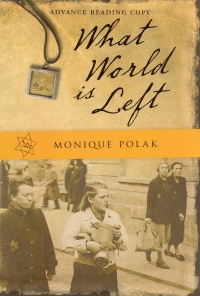| ________________
CM . . .
. Volume XV Number 5. . . .October 24, 2008
excerpt:
When young Anneke Van Raalte was growing up in The Netherlands, she was only dimly aware of Hitler's rise to power in Germany. Monique Polak's fictional heroine is an artist/cartoonist's daughter who lives with her parents and younger brother in comfortable circumstances. When the Germans invade and occupy Holland in the spring of 1940, the teenager's troubles begin. Nazi racist policies require Jews like the Van Raaltes to stay out of public parks and Christian homes and to wear a yellow cloth star over their hearts when they go outdoors. By 1942, students from the Joodse Lyceum (the Jewish high school) start disappearing, either transported by the Germans or in hiding. Anneke's father is imprisoned because of his Hitler cartoon, but he is released because the case against him is weak. Then, in April 1943, comes the news that the Van Raaltes are to be transported from Amsterdam to Theresienstadt. Monique Polak's novel was inspired the experiences of her mother, Celien Polak, who, with her parents and two siblings, was imprisoned at Theresienstadt for a little over two years. There, Monique's grandfather, a Dutch artist like the fictional Anneke's father, did commercial art for the Nazis. What World is Left is a work of fiction based on true events. Polak explains in her "Author's Note" that several scenes are based on her mother's experiences. Others were inspired by a book her grandfather wrote and published in 1978, in Dutch. "I have made every effort to be historically accurate throughout What World is Left," writes Monique, "but the central characters and their inner struggles are entirely imagined." At the end of the novel, Polak gives basic information about Theresienstadt. Readers should turn to the information in the "Author's Note" first, or look at some of the "Selected Websites" to fully grasp the plight of the prisoners in Theresienstadt. Theresienstadt was a concentration camp established by Nazi Germany in 1941 in the city of Terezin, ninety miles north of Prague. By the spring of 1942, non-Jewish Czechoslovakian residents of Terezin had been expelled, and the town became a closed environment for Jews. It served three functions; it was a transit camp for European Jews being shipped to Auschwitz, a ghetto labour camp for educated Jews, and a propaganda tool. Prisoners included intellectuals and luminaries in the arts, sciences and professions. Their talents were put to serve the Nazi regime. The children of the camp (some 15,000, few of whom survived the war) wrote stories and poems which were saved and which later became the collection I Never Saw Another Butterfly: Children's Drawings and Poems from Theresienstadt Concentration Camp, 1942-44, edited by Hana Volavkova (Schocken Books, 1993). Daily life was a miserable grind of overwork, overcrowding, malnutrition, vermin, dirt and illness, punctuated by episodes of violence against prisoners by guards. In a diabolical move to turn prisoner against prisoner, the Nazis made a "council of elders" (inmates) responsible for deciding who was unproductive and, therefore, fated for shipping to camps farther east. Dread hung over all. "The one goal - the only goal - at Theresienstadt," says Anneke, "is to keep your name and the names of those you love off the transport lists. But transports are as much a part of life here as bedbugs and latrines." Through Anneke's eyes, author Monique Polak presents an astonishing and depressing event - the duping of a Danish Red Cross delegation which came to inspect the camp in June, 1944. The "embellishment" not only involved fabricating fake shops, cafes and schools but also the deportation of many inmates to Auschwitz so that the overcrowding at Theresienstadt wouldn't be so noticeable. Prisoners remaining at Theresienstadt had no choice but to cooperate as an uprising would have been futile and fatal. Also, the work required to perpetrate the hoax meant a need for their labour - and their continued existence. They were playing for time. The Nazis also forced the prisoners to make a propaganda film: Terezin, A Documentary Film of the Jewish Resettlement, often called "The Fuhrer Gives a Village to the Jews." Anneke describes how the famous actor/director Kurt Geron was co-opted into directing the film. In her view, although he was compelled to direct, he also enjoyed the chance to work in his field of expertise. Upon completion of the film, he and the cast were sent to their deaths. As the Red Army pushed westward, prisoners from camps in the east, many with typhus, were shipped to Theresienstadt, bringing with them the news that the rumours about genocide were all too true. After the Russians liberated Theresienstadt, Anneke and her family return to Holland. Suffering from post-traumatic shock, Anneke hardly remembers how to live in a normal home, and she finds it hard to cope with people who don't understand what she has been through. The novel ends with a quote from the poet Heinrich Heine: "Think what world is left you still, and how lovely is that part." Recommended. Ruth Latta's latest novel is An Amethyst Remembrance (Ottawa, Baico, 2008).
To comment
on this title or this review, send mail to cm@umanitoba.ca.
Copyright © the Manitoba Library Association. Reproduction for personal
use is permitted only if this copyright notice is maintained. Any
other reproduction is prohibited without permission.
NEXT REVIEW |
TABLE OF CONTENTS FOR THIS ISSUE
- October 24, 2008.
AUTHORS |
TITLES |
MEDIA REVIEWS |
PROFILES |
BACK ISSUES |
SEARCH |
CMARCHIVE |
HOME |
